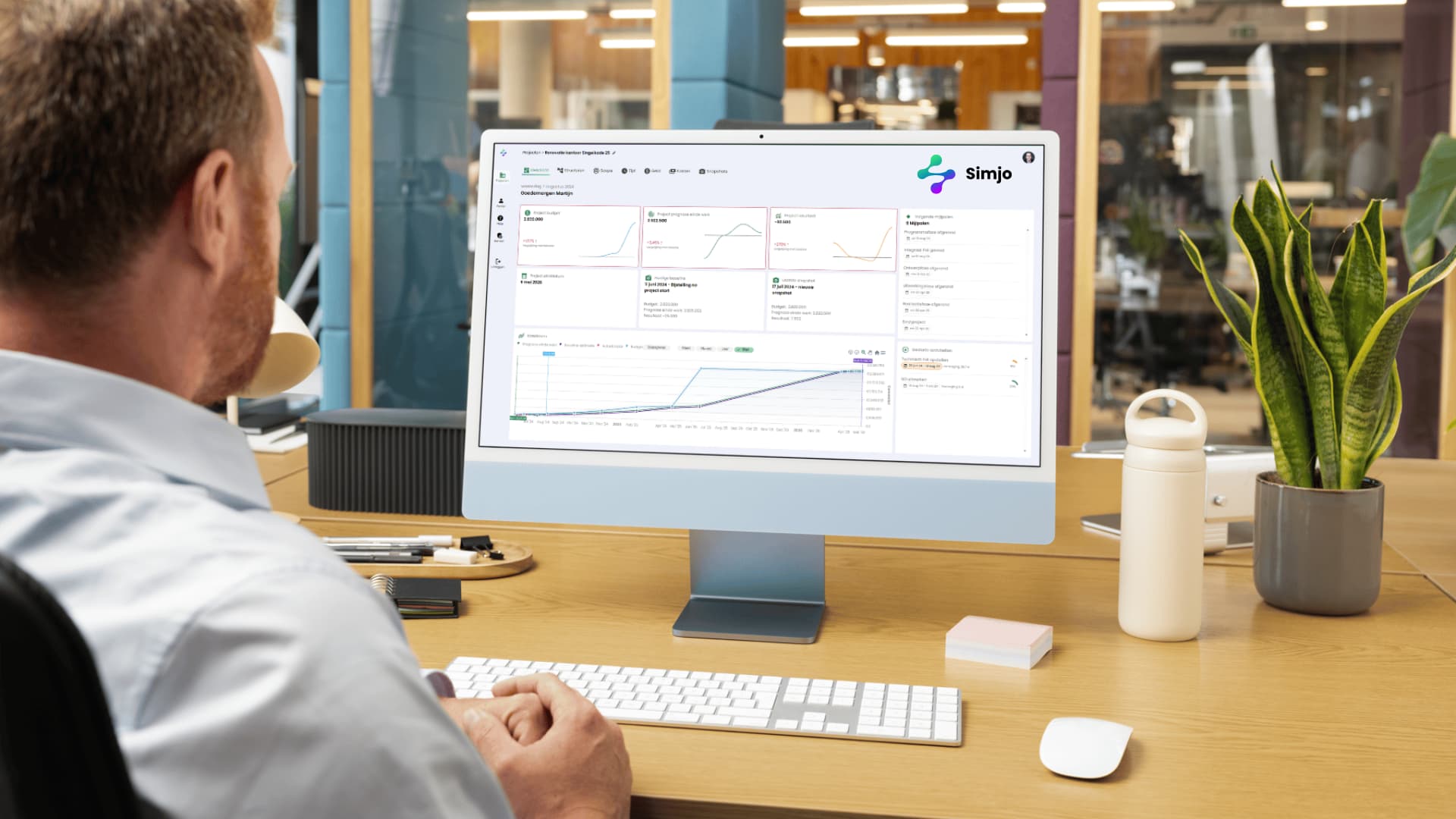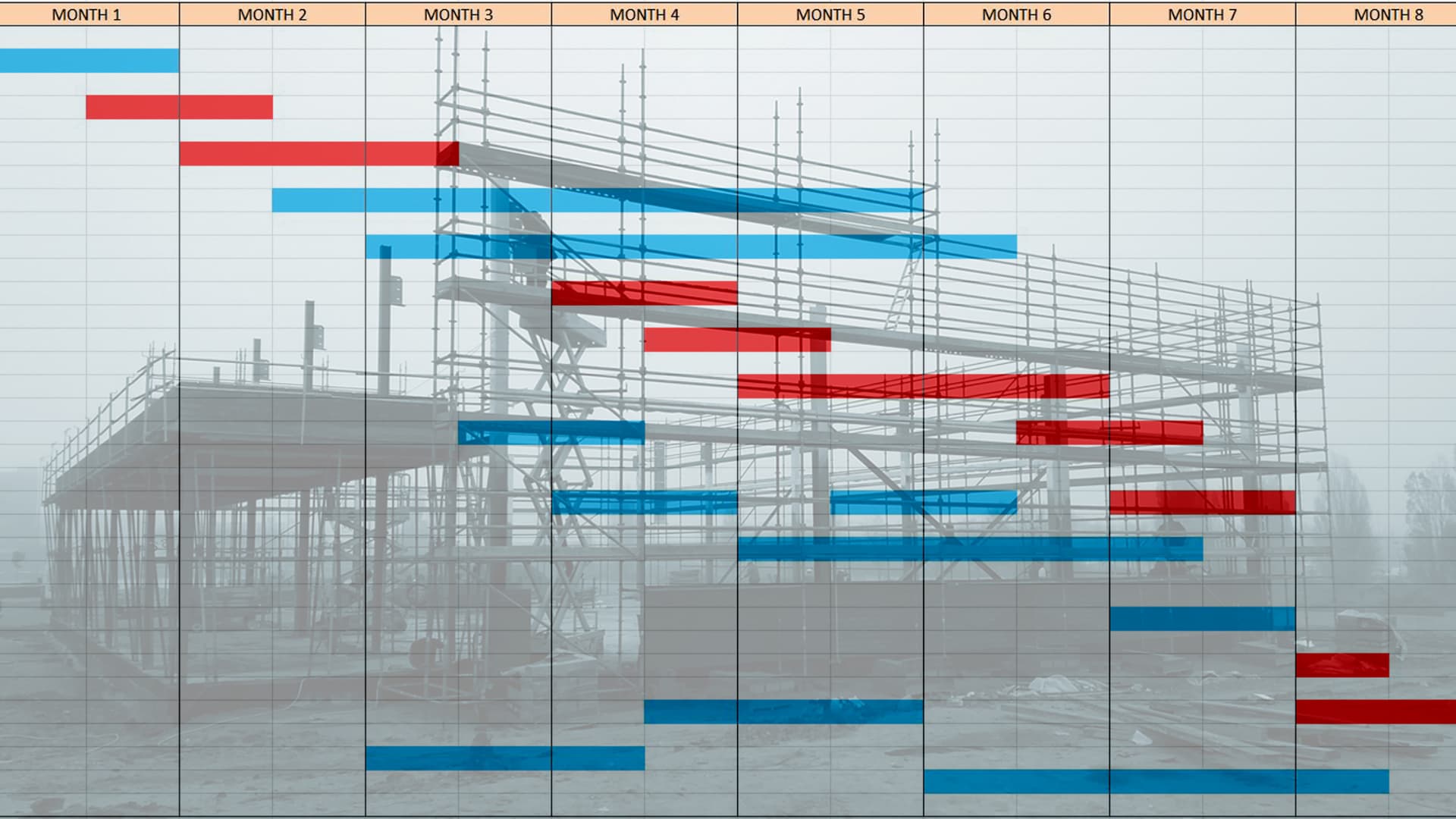Blogs
Benefits of Simjo Construction Planning Software

As a construction project manager, you know how crucial good planning is to the success of your project. Effective construction planning helps you meet deadlines, control costs and ensure quality of work.
In this article, we dive deeper into exactly what a construction schedule is, what components belong in it, and how Simjo’s software helps you manage your construction projects more efficiently.
What Is a Construction Schedule?
A construction schedule is a detailed overview of all activities and milestones in a construction project, from start to completion. It serves as a roadmap for the project team and helps get everyone on the same page.
A well-drafted construction schedule provides insight into the following aspects:
- Timeline and phasing of the project
- Required resources such as manpower, materials, and equipment
- Dependencies and relationships between different activities
- Critical path and possible bottlenecks
- Budgeting and cost control
By mapping all these elements, you are better able to anticipate challenges and keep the project running smoothly.
Essential Elements of a Construction Schedule
Construction projects often face various challenges that affect planning and progress. A common problem is delays in the delivery of materials, which bring work to a halt. Unforeseen circumstances such as adverse weather conditions or design changes also often lead to delays.
In addition, personnel capacity issues or miscommunication between the various parties involved often cause problems. This results in errors, additional costs, and further delays.
Thus, to create an effective construction schedule, it must include several key components:
1. Work Breakdown Structure (WBS)
This is a hierarchical breakdown of the project into manageable tasks and work packages. It helps make the project manageable and assign responsibilities.
2. Timetable
A detailed schedule with start and end dates for each activity, taking into account dependencies and resource availability.
3. Resource planning
An overview of the manpower, materials, and tools needed for each task so that you can ensure sufficient capacity and timely delivery.
4. Milestones
Clearly defined milestones mark the completion of key phases or deliverables so you can monitor and communicate progress to stakeholders.
Also read: 5 Trends And Tips in Construction Project Management
5. Risk analysis
Identification of potential risks and development of contingency plans to avoid delays or additional costs.
By including these elements in your construction planning, you create a solid foundation for a successful construction project.
Benefits of Construction Planning Software
Although you can create a construction schedule using Excel spreadsheets or other project management tools, specialized construction planning software offers a number of advantages:
1. Saving time
A scheduling program automates many tasks such as resource allocation and updates, leaving you more time for other important project management tasks. By using dedicated construction scheduling software, you are taking advantage of best practices in construction.
2. Improved collaboration
Cloud-based construction scheduling software enables the entire construction team to have real-time access to the latest version of the construction schedule, make changes, and collaborate.
3. Prevents unnecessary costs
Careful planning also helps avoid unnecessary costs. You avoid situations in which hired parties cannot start work because preparatory work has not yet been completed. This way, you avoid additional work due to poor coordination.
4. Insight and reporting
With just a few clicks, you generate clear reports and dashboards visualizing the progress, resource usage, and bottlenecks of your construction project, allowing you to make adjustments quickly where necessary.
5. Integration with other systems
Construction planning software is easy to link to other tools such as BIM, ERP, or financial systems, for a seamless exchange of data about your construction project.
5. Risk management
Specialized construction planning software helps identify potential delays, conflicts, or resource shortages so you can take proactive action.
By using specialized construction planning software, you can manage your projects more efficiently, communicate better with your team and stakeholders, and ultimately achieve better results.
Also read: Why Excel is not an appropriate tool for construction project management
7. Certainty of delivery
A well-thought-out construction schedule is essential for the successful completion of a construction project. It provides clarity on the work required, the order in which it should be carried out, and the estimated duration. This prevents delays because it is clear which tasks depend on the completion of other tasks. This also makes it possible to order materials at the right time.
8. Ensures quality
Finally, good construction planning contributes to the quality of the result. If there is no clear planning, conflicts or problems arise more easily and are sometimes resolved at the expense of quality. A structured approach ensures that all work is carried out at the right time and in the right way, which improves quality.
7 Steps to Effective Construction Planning
A construction schedule is created based on the steps in the construction process. This gives a clear structure to the planning.
Step 1: Define the scope of the project
Planning starts with proper preparation, where you define the goal and desired result of the project. Clearly define the scope, or scope, of your construction project. What are the specific objectives and requirements? Draw up a Schedule of Requirements together with your client. A detailed list of all tasks from design to completion. This will help you get a complete picture of what needs to be done.
Step 2: Divide the project into phases
Divide your project into logical phases. For example, these could be the design phase, the construction preparation phase, the construction phase, and the finishing phase. Dividing your project into manageable parts makes it easier to plan and manage.
Step 3: Identify the resources needed
Determine what resources you will need for each phase of the project. This includes materials, tools, equipment, and labor. Make a list of all required items and estimate quantities and costs. This will help you plan your budget accurately.
Step 4: Develop a timeline
Create a detailed timeline for your project. Start with the end date and work back to the present. Assign realistic timeframes to each task determining how long a task will take. Be careful, if you don’t schedule enough time to complete a task, it could have consequences right to the end of the construction project.
Take into account any dependencies between tasks. If one task has to be finished before you can start another, make sure this first task is given priority.
Provide some slack in your schedule to accommodate unforeseen delays.
And take into account others’ schedules, longer delivery times, or waiting times for a permit, for example.
Step 5: Assign responsibilities
Assign clear responsibilities to each member of your project team. Make sure everyone knows what is expected of them and when their tasks must be completed. Good communication and coordination are essential for the project to run smoothly.
Step 6: Obtain the necessary permits
Make sure you obtain all necessary permits and approvals before you start building. This can take some time, so plan this early in the process. Take into account any waiting times when drawing up your timeline.
Step 7: Plan orders and deliveries
Plan your material orders and deliveries carefully. Make sure you have the right items on-site at the right time. Also, take delivery times sufficiently into account. Proper planning of logistics prevents delays and extra costs.
How does Simjo’s construction planning software work?
There are also digital tools to help create and keep track of construction planning. Simjo, for instance, offers a powerful and user-friendly construction planning program designed specifically for the needs of project managers in the construction industry. Some key features include:
- Real-time collaboration: The entire project team can simultaneously work on the schedule, make changes and see each other’s progress, for optimal coordination.
- Visual timeline: The software automatically generates a clear Gantt chart that clearly shows interdependencies and the critical path.
- Reporting and analysis: Generate powerful reports and dashboards with a few clicks that provide insight into progress, budget utilization, and potential bottlenecks.
With Simjo’s construction planning software, you have everything you need to efficiently plan, monitor, and complete your construction projects on budget and on schedule.
Conclusion
Well-thought-out construction planning is indispensable to the success of any construction project. By using specialized software like Simjo’s, you can streamline your planning process, improve collaboration, and achieve better results.
With features such as real-time updates, resource management, and powerful reporting, Simjo’s solution provides a complete package to take your construction projects to the next level. Experience the difference yourself and take your project management skills to the next level with Simjo’s construction scheduling software.
Would you also like to discover how Simjo supports your construction project?
Simjo is project management software designed specifically for construction project managers and project teams. Start for free and discover the capabilities of Simjo construction project management software!









